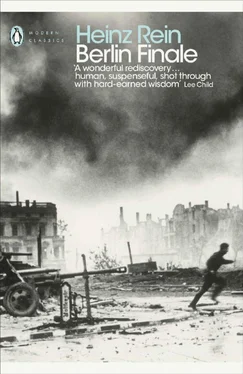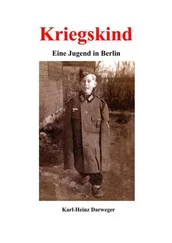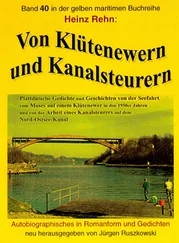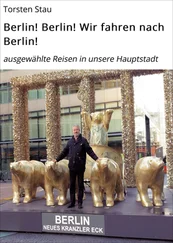The Reich Security Main Office of the SS had occupied the building on Kurfürstenstrasse. The intelligence service – Sicherheitsdienst, or SD: that was the harmless term for the powerful apparatus that had unlimited funds, was accountable to no one, was liable to no law and ignored every court, and whose sole task consisted in securing the power of the National Socialist Party with all means at its disposal, and ruthlessly destroying all opponents. From here the Sicherheitsdienst extended its feelers, vertically, horizontally, in every direction, into every dimension.
There was no area of life in Germany, and particularly in Berlin, that was not kept under surveillance from here. It was from here that the army of spies was dispatched and swept into every channel of public and private life, here that the flood of all reports, notifications and denunciations were collected. Nothing was too insignificant for the accountants and paymasters of death not to be registered here, noted in files or processed into files. From here the concentration camps were constantly fed with new human material, the law-breakers of the People’s Court were constantly given fresh victims. In this building the dignity of man was an unknown concept, and the freedom of the individual was replaced by compulsion into the community. People were divided into those who were for and those who were against the National Socialist state; all of those who were not for it or who were merely suspected of not being so were seen without further ado as opponents and treated accordingly. All the procedures that would not have shamed the cruellest judge of the Inquisition were dreamed up here, with the deployment of the services of all available technical experts. It was here that technical monstrosities were conceived to make possible the destruction, both profitable and unbridled, of millions of creatures judged to be of inferior race, and hence unworthy of life.
Kurfürstenstrasse, formerly one of the many streets in the old West Berlin that had nothing special about it, became a household name. There are many streets in Berlin which have, sometimes wrongly, become household names. So, for example, Ritterstrasse became synonymous with import and export, Ackerstrasse for the lumpenproletariat, Tauentzienstrasse for the sophisticated demimonde, Münzstrasse for the underworld, Lindenstrasse for social democracy and General Pape Strasse for round-ups and physical examinations. National Socialism alone retained the right to make street names synonymous with deadly terror, Prinz Albrecht Strasse, Burgstrasse, Kurfürstenstrasse, Grosse Hamburger Strasse – summonses from here spread fear and horror, because being accused generally meant being sentenced to detention in a concentration camp. Testimony was equivalent to an accusation of complicity.
In one of the rooms in the building on Kurfürstenstrasse there sits a big, stout man, he wears the uniform of the SD, four silver stars flash on his collar, the features of his broad, slightly bloated face are remarkably taut, his left cheek is split from mouth to ear by a great scar, his white-blond hair is slightly thin and carefully parted at the side, his pale-blue eyes have something of the colour of a chill winter sky.
This man, to whom all intelligence officers in the Berlin companies are accountable, is Sturmbannführer Wellenhöfer, director of the intelligence department of Berlin central office. He is feared because he has the reputation of being an ice-cold intellectual, a relentless sleuth, a ruthless go-getter. He is known to have access to no emotions, and to know no consideration. His smiling expression, which he displays both to his inferiors and to all visitors, and even to the unfortunate victims of his tracking dogs, is a calculated mask designed to lure others out of their reserve, and persuade them into confessing intimacies and indiscretions. Only someone who looked very closely at Wellenhöfer and gazed him attentively and fearlessly in the eye would recognize that his smile is not real, it is in a sense only applied to his face like a mask, through which only the eyes peer undisguised. Lips and eyes are not congruent in their expression, because while smiling wrinkles lie around the mouth and the teeth even flash now and then between the lips, there is a cold gleam in the eyes. Although Wellenhöfer demands short, clear, factual reports from his inferiors, tolerates no circumlocutions and abruptly dismisses any polite phrases, he lets the people who have the misfortune of being interrogated by him tell their stories at random, he never interrupts them, he even sometimes encourages them a little, but otherwise he maintains an agonizing silence. He knows that his victim will become more eloquent the longer he remains silent, and that the moment is eventually bound to come when the narrator will say things that he didn’t want to say. When this moment has come, Wellenhöfer pounces like a hawk, plunges his claws into the flesh of his victim and doesn’t let go until he has pulled out everything still hidden within. Wellenhöfer is a man who leaves nothing to chance. He runs all operations of any consequence himself, or at least directs them with precise instructions. He has an infallible eye for what is significant and would sooner forgive a big mistake committed in the heat of combat than an act of carelessness or failure to obey an order.
On the morning of 15 April 1945 he is sitting opposite a civilian. It is not difficult to tell from his posture that a massive burden lies on his bent back, he is sitting on the outer edge of a chair, his arms are pressed tightly against his sides and bent in front of his chest, his fingers play nervously with the buttons of his waistcoat, his head is drawn deeply back between his shoulders, his gaze is uncertain and leaps from point to point, but he assiduously avoids the eye of the Sturmbannführer.
This man is Reichsbahn Senior Inspector Deiters, the intelligence delegate of the Karlhorst depot of the Deutsche Reichsbahn. It isn’t the first time that he’s been in this room with Wellenhöfer. Since a series of malfunctions had occurred at the Karlhorst depot, which can only be put down to sabotage, he has been repeatedly ordered to Kurfürstenstrasse. Every time he has been asked by Wellenhöfer, in increasingly harsh tones, whether he had still not managed to catch the perpetrator or perpetrators, or at least prevent the continuation of the acts of sabotage through keen surveillance. Repeatedly Deiters had not only had to answer in the negative, but even to admit that here, once again, a locomotive has been rendered useless, that a coal crane has become inoperative, that the number of incidences of overheating is increasing all the time and that one day even the transfer table in the big workshop has been so badly damaged that a number of locomotives were blocked and unable to leave the depot. Once the perpetrator had almost been caught while planting explosives in the smokebox of one of the steam locomotives, but at the last moment he had been able to defend himself against his pursuer with a monkey wrench and had disappeared into the darkness of the great hall. Still, and this was the only positive aspect of the nocturnal scuffle, they had come a step further since they now knew that the perpetrator was without a doubt a German because he had, when he had been caught closing the smokebox, uttered a curse between his teeth, one that no foreigner could have used. But that had been all, in spite of the tightening network of surveillance and control they had not advanced a single step further. It was only clear that the perpetrator was to be sought among those employed in the factory, because apart from his precise knowledge of the work terrain with its locomotive halls, wagon sheds, boiler houses, crane plants, workshops, signal systems, water cranes, clinker pits, tracks and points, the form of the sabotage had also revealed an excellent knowledge of the subject, because with a minimum of effort a maximum of destruction had been achieved.
Читать дальше












